1997 BUICK PARK AVENUE hood open
[x] Cancel search: hood openPage 83 of 420
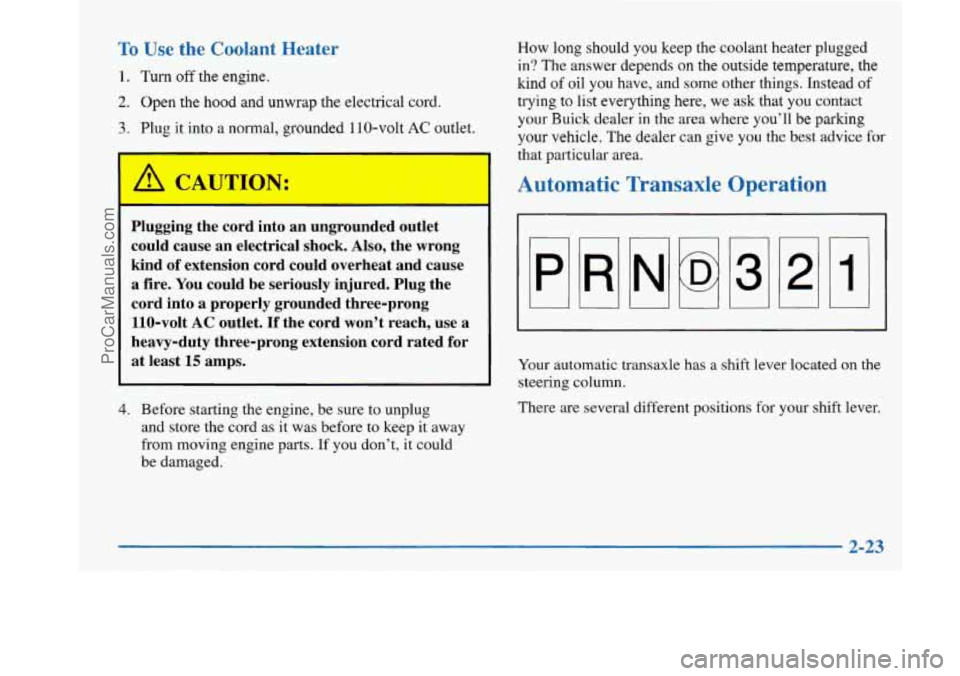
To Use the Coolant Heater
1. Turn off the engine.
2. Open the hood and unwrap the electrical cord.
3. Plug it into a normal, grounded 110-volt AC outlet.
Plugging the cord into an ungrounded outlet
could cause an electrical shock.
Also, the wrong
kind of extension cord could overheat and cause
a fire. You could be seriously injured. Plug the
cord into
a properly grounded three-prong
110-volt
AC outlet. If the cord won’t reach, use a
heavy-duty three-prong extension cord rated for
at least 15 amps.
4. Before starting the engine, be sure to unplug
and store the cord as it was before to keep it away
from moving engine parts. If you don’t, it could
be damaged. How long should
you keep the coolant heater plugged
in? The answer depends on the outside temperature, the
lund
of oil you have, and some other things. Instead of
trying to list everything here, we ask that you contact
your Buick dealer in the area where you’ll be parking
your vehicle. The dealer can give you the best advice
for
that particular area.
Automatic Transaxle Operation
Your automatic transaxle has a shift lever located on the
steering column.
There are several different positions for your shift lever.
2-23
ProCarManuals.com
Page 157 of 420
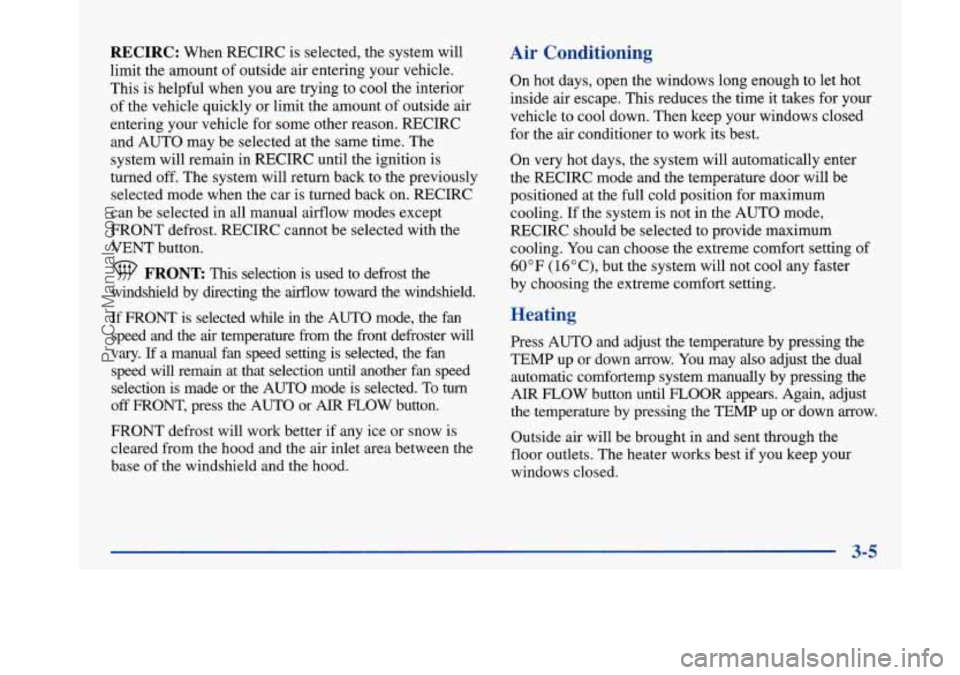
RECIRC: When RECIRC is selected, the system will
limit the amount of outside air entering your vehicle.
This is helpful when you
are trying to cool the interior
of the vehicle quickly or limit the amount of outside air
entering your vehicle for some other reason. RECIRC
and AUTO may be selected at the same time. The
system will remain in RECIRC until the ignition is
turned
off. The system will return back to the previously
selected mode when the car is turned back on. RECIRC
can be selected in all manual airflow modes except
FRONT defrost. RECIRC cannot be selected with the
VENT button.
FRONT This selection is used to defrost the
windshield by directing the airflow toward the windshield.
If FRONT is selected while in the AUTO mode, the fan
speed and the
air temperature from the front defroster will
vary.
If a manual fan speed setting is selected, the fan
speed will remain
at that selection until another fan speed
selection is made or the AUTO mode is selected. To turn
off FRONT, press the AUTO or AIR FLOW button.
FRONT defrost will work better if any
ice or snow is
cleared from the hood and the air inlet area between the
base of the windshield and the hood.
Air Conditioning
On hot days, open the windows long enough to let hot
inside air escape. This reduces the time it takes for your
vehicle
to cool down. Then keep your windows closed
for the air conditioner to work its best.
On very hot days, the system will automatically enter
the RECIRC mode and the temperature door will be
positioned at the full cold position for maximum
cooling. If the system is not in the AUTO mode,
RECIRC should be selected to provide maximum
cooling.
You can choose the extreme comfort setting of
60°F (16"C), but the system will not cool any faster
by choosing the extreme comfort setting.
Heating
Press AUTO and adjust the temperature by pressing the
TEMP up or down arrow. You may also adjust the dual
automatic comfortemp system manually by pressing the
AIR FLOW button until FLOOR appears. Again, adjust
the temperature by pressing the TEMP up or down arrow.
Outside air will be brought in and sent through the
floor outlets. The heater works best if you keep your
windows closed.
3-5
ProCarManuals.com
Page 232 of 420
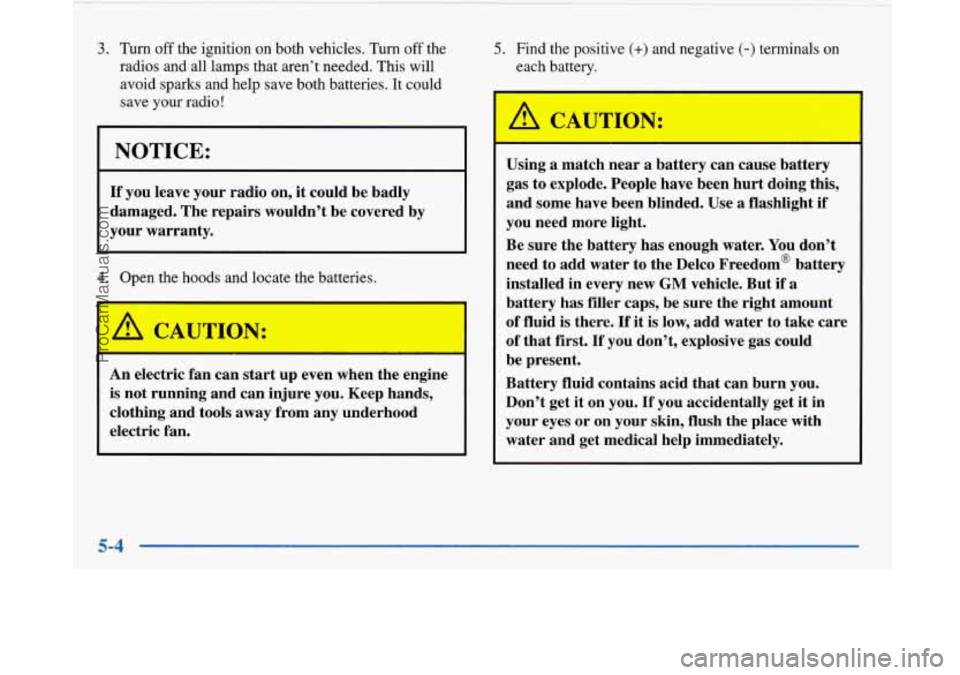
3. Turn off the ignition on both vehicles. Turn off the
radios and all lamps that aren’t needed. This will
avoid
sparks and help save both batteries. It could
save your radio
!
NOTICE:
If you leave your radio on, it could be badly
damaged. The repairs wouldn’t be covered by
your warranty.
4. Open the hoods and locate the batteries.
A CAUTION:
An electric fan can start up even when the engine
is not running and can injure you. Keep hands,
clothing and tools away from any underhood
electric fan.
5. Find the positive (+) and negative (-) terminals on
each battery.
A CAUTION:
Using a match near a battery can cause battery
gas to explode, People have been hurt doing this,
and some have been blinded, Use a flashlight if
you need more light.
Be sure the battery has enough water. You don’t
need
to add water to the Delco Freedom@ battery
installed in every new
GM vehicle. But if a
battery has filler caps, be sure the right amount
of fluid is there.
If it is low, add water to take care
of
that first. If you don’t, explosive gas could
be present.
’ Battery fluid contains acid that can burn you.
Don’t get
it on you. If you accidentally get it in
your eyes or on your skin, flush the place with
water and get medical help immediately.
5-4
ProCarManuals.com
Page 240 of 420

Engine Overheating
You will find a warning light about a hot engine, as well
as a coolant temperature gage,
on your Buick instrument
panel.
If your vehicle is equipped with the optional
Driver Information Center, an Engine Coolant Low
warning will appear
on the display.
If Steam Is Coming From Your Engine
Steam from an overheated engine can burn you
badly, even
if you just open the hood. Stay away
from the engine if you see or hear steam coming
from it. Just turn
it off and get everyone away
from the vehicle until
it cools down. Wait until
there
is no sign of steam or coolant before you
open the hood.
If you keep driving when your engine is
overheated, the liquids in it can catch fire. You or
others could be
badly burned. Stop your engine if
it overheats, and get out of the vehicle until the
engine is cool.
NOTICE:
If your engine catches fire because you keep
driving with no coolant, your vehicle can be
badly damaged. The costly repairs would not be
covered
by your warranty.
5-12
ProCarManuals.com
Page 241 of 420

If No Steam Is Coming From Your Engine
If you get the overheat warning but see or hear no
steam, the problem may not be too serious. Sometimes
the engine can get a little too hot when you:
Climb a long hill on a hot day.
Stop after high-speed driving.
Idle for long periods in traffic.
Tow a trailer.
If you get the overheat warning with no sign of steam,
try this for
a minute or so:
1. Turn off your air conditioner.
2. Turn on your heater to full hot at the highest fan
speed and open the window as necessary.
3. If you’re in a traffic jam, shift to NEUTRAL (N);
otherwise, shift to the highest gear while
driving
-- AUTOMATIC OVERDRIVE (0)
or THIRD (3).
If you no longer have the overheat warning, you
can drive. Just to be safe, drive slower for about
10 minutes. If the warning doesn’t come back on,
you can drive normally.
If the warning continues, pull over, stop, and park your
vehicle right away.
If there’s still no sign of steam, you can idle the engine
for two or three minutes while you’re parked, to see if
the warning stops.
But then, if you still have the
warning,
turn ofthe engine and get everyone out of the
vehicle
until it cools down.
You may decide not to lift the hood but to get service
help right away.
5-13
ProCarManuals.com
Page 268 of 420
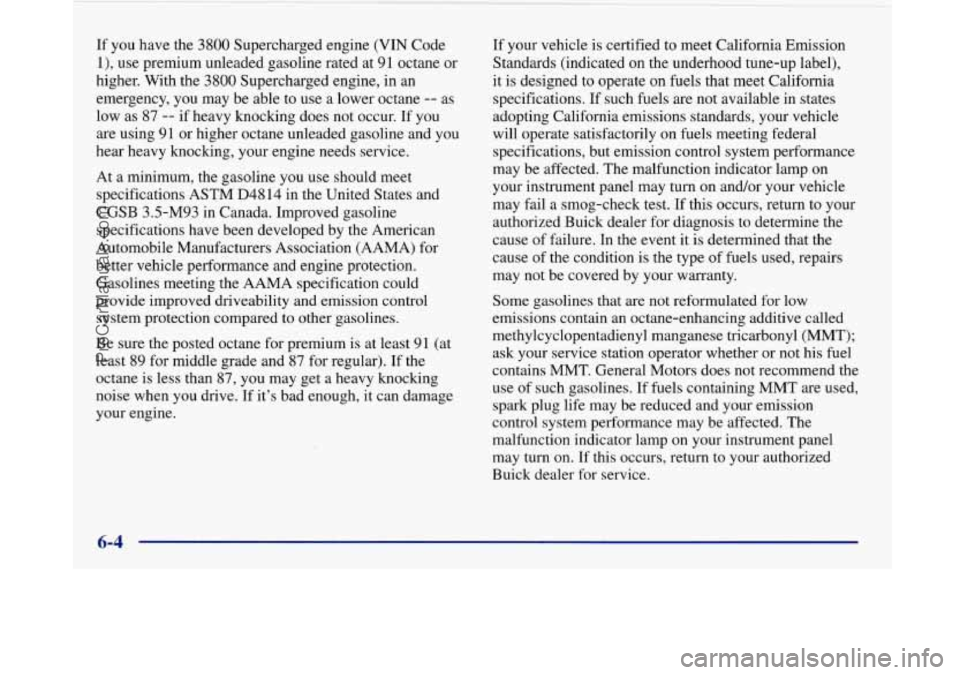
If you have the 3800 Supercharged engine (VIN Code
l), use premium unleaded gasoline rated at 91 octane or
higher. With the
3800 Supercharged engine, in an
emergency, you may be able to use a lower octane
-- as
low as
87 -- if heavy knocking does not occur. If you
are using 91 or higher octane unleaded gasoline and you
hear heavy knocking, your engine needs service.
At a minimum, the gasoline you use should meet
specifications ASTM D4814 in the United States and
CGSB 3.5-M93 in Canada. Improved gasoline
specifications have been developed by the American
Automobile Manufacturers Association (AAMA) for
better vehicle performance and engine protection.
Gasolines meeting the AAMA specification could
provide improved driveability and emission control
system protection compared to other gasolines.
Be sure the posted octane for premium is at least 91 (at
least 89 for middle grade and
87 for regular). If the
octane is less than
87, you may get a heavy knocking
noise when you drive. If it’s bad enough, it can damage
your engine.
If your vehicle is certified to meet California Emission
Standards (indicated on the underhood tune-up label),
it is designed to operate on fuels that meet California
specifications.
If such fuels are not available in states
adopting California emissions standards, your vehicle
will operate satisfactorily on fuels meeting federal
specifications, but emission control system performance
may be affected. The malfunction indicator lamp on
your instrument panel may turn on and/or your vehicle
may fail a smog-check test. If this occurs, return to your
authorized Buick dealer for diagnosis to determine the
cause of failure. In the event it is determined that the
cause of the condition is the type of fuels used, repairs
may not be covered by your warranty.
Some gasolines that are not reformulated for low
emissions contain an octane-enhancing additive called
methylcyclopentadienyl manganese tricarbonyl (MMT);
ask your service station operator whether or not his fuel
contains MMT. General Motors does not recommend the
use of such gasolines. If fuels containing MMT are used,
spark plug life may be reduced and your emission
control system performance may be affected.
The
malfunction indicator lamp on your instrument panel
may turn
on. If this occurs, return to your authorized
Buick dealer for service.
6-4
ProCarManuals.com
Page 273 of 420
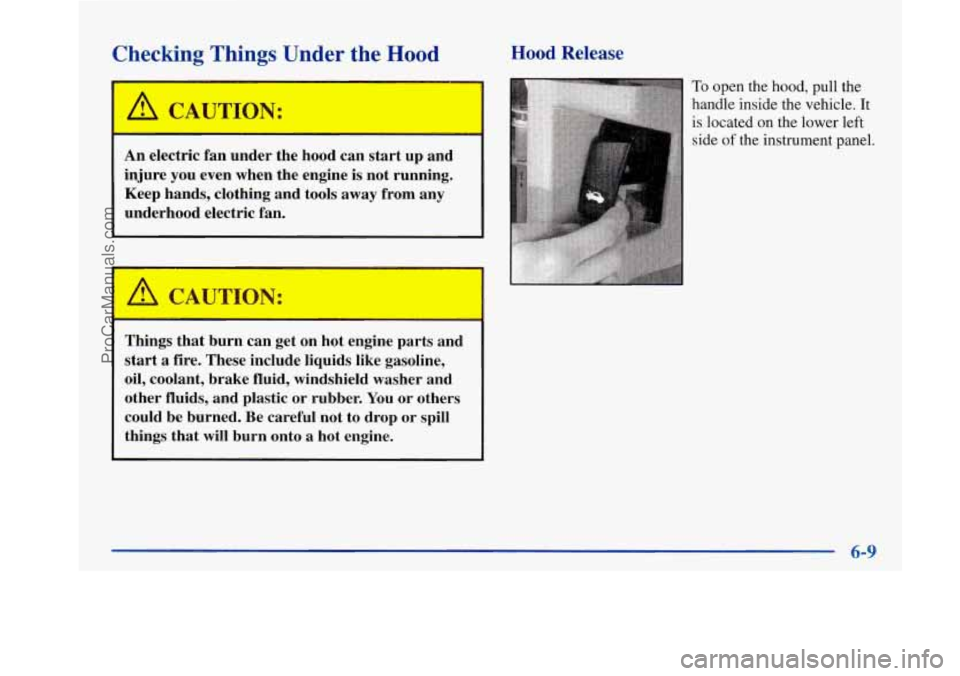
Checking Things Under the Hood Hood Release
A CAUTION:
An electric fan under the hood can start up and
injure you even when the engine is not running.
Keep hands, clothing and tools away from any
underhood electric fan.
A CAUTION: I I
Things that burn can get on hot engine parts and
start a fire. These include liquids like gasoline,
oil, coolant, brake fluid, windshield washer and
other fluids, and plastic or rubber. You or others
could be burned. Be careful not
to drop or spill
things that will burn onto a hot engine.
To open the hood, pull the
handle inside the vehicle. It
is located on the lower left
side
of the instrument panel.
6-9
ProCarManuals.com
Page 275 of 420
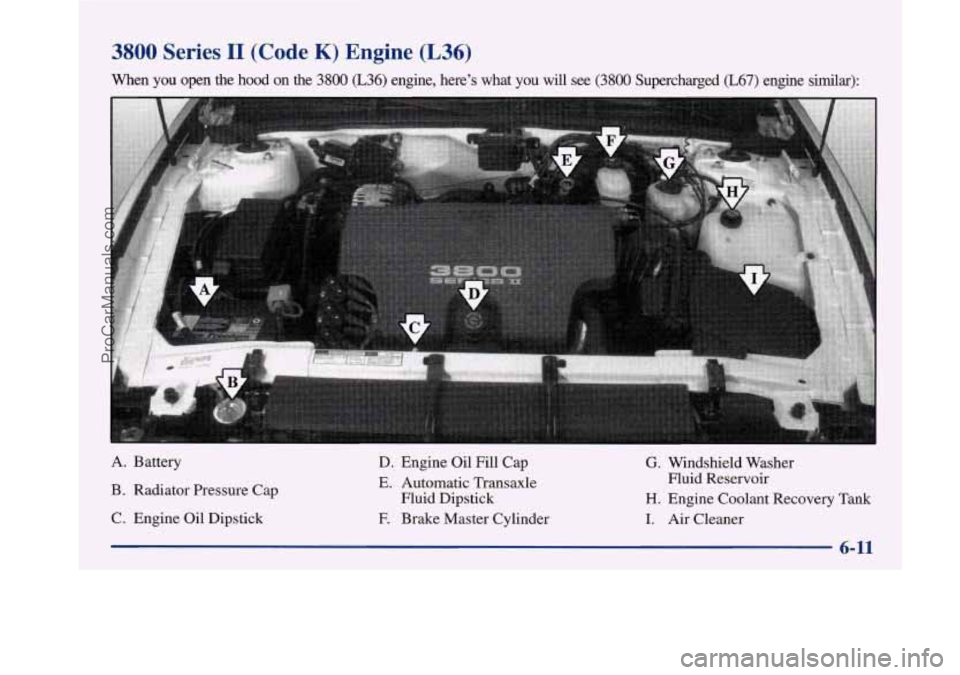
3800 Series I1 (Code K) Engine (L36)
When you open the hood on the 3800 (L36) engine, here’s what you will see (3800 Supercharged (L67) engine similar):
“14 ,....
A. Battcry
D. Engine Oil Fill Cap G. Windshield Washer
B
. Radiator Pressure Cap
C. Engine Oil Dipstick E.
Automatic Transaxle
Fluid Dipstick
F. Brake Master Cylinder Fluid Reservoir
H. Engine Coolant Recovery
Tank
I. Air Cleaner
6-11
ProCarManuals.com